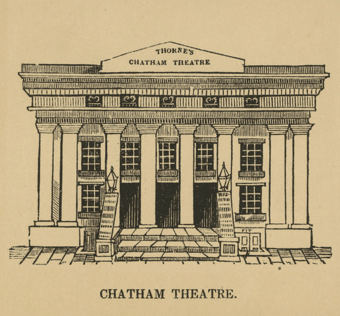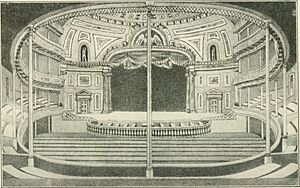Chatham Garden Theatre facts for kids

The only known image of the Chatham Garden Theatre's exterior
|
|
| Address | New York City United States |
|---|---|
| Construction | |
| Opened | May 17, 1824 |
| Years active | 1824-1832 |
| Architect | George Conklin |
The Chatham Garden Theatre was a famous playhouse in New York City. It was located in an area called Chatham Gardens in lower Manhattan. The theatre was built on Chatham Street between Pearl and Duane streets.
This theatre was the first big rival to the fancy Park Theatre. Over time, the Chatham Garden Theatre became less high-class. It ended up being known as a place for more casual entertainment. In 1832, the building was changed into a church called the Free Presbyterian Chatham Street Chapel.
Contents
Building the Chatham Garden Theatre
The Chatham Garden Theatre started in a very simple way. In 1823, a man named Hippolite Barrière managed the Chatham Gardens. He set up a white canvas tent in his public park. He called it the Pavilion Theatre. Here, he put on plays, and tickets cost 25 cents. This tent was also used for concerts and had a saloon. It might have been the first summer theatre in the United States.
Stephen Price, who managed the Park Theatre, tried to stop Barrière. He told the authorities the tent was a fire hazard. So, Barrière built a proper brick building instead. This new building was named the Chatham Garden Theatre. It opened on May 17, 1824, and had shows during the regular theatre season.
The theatre was a beautiful building designed by George Conklin. It didn't have a traditional gallery (upper seating area). Also, it did not allow African Americans to attend. The balcony was on the same level as the lobby and faced the garden. The walls had openings and the doorways had blinds to help air flow through.
A visitor named Karl Bernhard described the theatre in 1825-1826:
. . . in Chatham [Garden] Theatre, situated at the extremity of a public garden, they performed the melo-drama of the Lady of the Lake tolerably well. I was much pleased with the inside of the theatre, and particularly with the decorations; it was full of people, and the heat extreme. Ladies of the first fashion do not go often to the theatre. In the pit persons pulled off their coats, in order to be cool.
Finding the theatre was a bit tricky. You had to walk through private buildings on Chatham Street to get there. The New-York Mirror newspaper gave these directions:
[T]he entrance to the theatre is through the hall of [a] dwelling house on Chatham Street. . . . [Y]ou proceed onward to the fountain, which throws up a refreshing column of pure water directly in front of the folding doors to the theatre. Passing through these doors you ascend, by a double flight of stairs (to the right and left) to the lobby of the first circle of boxes.
The Chatham Garden Theatre became popular. It offered good actors and fair ticket prices. It was the first real competitor for the fancy Park Theatre. For its first three seasons, it remained a high-quality place. During this time, it showed the first two American operas: The Sawmill in 1824 and The Forest Rose in 1825.
Changes in Management and Shows
Hippolite Barrière, the first manager, passed away on February 21, 1826. The theatre was then sold to Henry John Wallack for $4,500. Wallack reopened it in March for a four-month season. He then updated the theatre before reopening it in October 1826. However, Wallack faced financial trouble and had to close the theatre in April 1827.
After Wallack, new managers changed the theatre's focus. Instead of high-class plays and opera, they offered shows that appealed to a wider audience. A man named Megary managed a few short seasons. Then, Kilner and Maywood took over in 1828.
In 1829, James H. Hackett took charge and renamed the building the American Opera House. He put on two seasons of mostly light, popular music. After him, George Barrett and C. Young managed it for a very short time. In 1830, the Opera House became Blanchard's Amphi-theatre. This place specialized in horse shows and light plays. Other managers followed, including S. Phillips and Charles R. Thorne. Finally, Thomas S. Hamblin bought the theatre in June 1831. The 1831-1832 season was its very last.
After Barrière's death, the Chatham Garden Theatre became less formal. It was seen as the least fancy of New York's three big theatres (the others were the Park and the Bowery). A writer named Frances Trollope described the theatre:
The Chatham is so utterly condemned by bon ton, that it requires some courage to decide upon going there; nor do I think my curiosity would have penetrated so far, had I not seen Miss Mitford's Rienzi advertised there. It was the first opportunity I had had of seeing it played, and in spite of very indifferent acting, I was delighted. The interest must have been great, for till the curtain fell, I saw not one quarter of the queer things around me; then I observed in the front row of a dress-box a lady performing the most maternal office possible, several gentlemen without their coats, and a general air of contempt for the decencies of life, certainly more than usually revolting.
This description suggests the theatre was more relaxed. People were comfortable taking off their coats. The presence of a mother caring for her baby also shows it was a family-friendly place, even if it wasn't considered "high society."
From Theatre to Chapel
In the spring of 1832, Lewis Tappan and William Green rented the building. They offered it to Charles Grandison Finney, a Presbyterian minister. Finney was a strong supporter of ending slavery. He turned the theatre into the Free Presbyterian Chatham Street Chapel.
In October 1832, this chapel hosted the first national Sunday School convention in the United States. For the next ten years, Finney gave sermons every Sunday to large crowds, sometimes as many as 3,000 people. He also led religious revival events three times a week. A popular religious choir called the Sacred Music Society also used the building for two nights a week.
Philip Hone described a performance he saw there in 1835:
[I was] astonished at the magnificence of the scene. The audience, of whom a large proportion were ladies, must have amounted to between 2000 and 3000 . . . . the chorus consisted of upwards of a hundred, the females all draped alike in white and arranged on opposite sides of the music gallery, formed an interesting and beautiful coup d'oeil. The ground floor, which is very capacious, and two large galleries were so crowded that I could scarcely find standing room behind the benches . . . .
In its later years, the church building became a hotel. The building has since been taken down. Today, the land is the site of a Metropolitan Correctional Center, a government facility.
Images for kids




